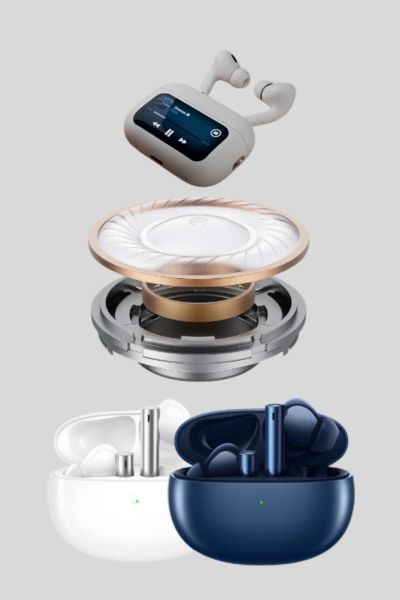Apple’s AirPods have emerged as a symbol of innovation and ease in the world of wireless audio technology. These elegant, wireless earbuds have transformed the way we listen to music by enabling cord-free connectivity to our favourite gadgets. In this blog article, we’ll dig into the complex world of technology that drives the AirPods, looking at the hardware, software, and engineering marvels that set them apart from the competition.

1. Bluetooth Connectivity in AirPods: The Backbone of Wireless Freedom
Bluetooth technology is at the heart of AirPods’ connectivity via Bluetooth. Apple uses the most recent Bluetooth standards to provide a stable and efficient connection between the AirPods and Apple products like iPhones, iPads, and MacBooks. The widespread use of Bluetooth technology allows customers to enjoy cordless and cable-free listening experiences.
Bluetooth Low Energy (BLE), a power-efficient form of Bluetooth, is used by the AirPods to ensure that the earbuds consume less energy while maintaining a steady connection. This not only extends the AirPods’ battery life but also improves the user experience as a whole.
2. Custom-designed Apple H1 Chip: Powering Performance
The custom-designed Apple H1 chip is one of the significant technological achievements of the AirPods. This little yet powerful piece of silicon is critical to providing a smooth and responsive user experience. The H1 chip is in charge of activities including audio processing, wireless networking, and power consumption control.
The incorporation of the H1 chip within the AirPods allows for capabilities like quick connection with Apple devices, automatic switching between devices, and hands-free “Hey Siri” capability. This chip demonstrates Apple’s dedication to improving both hardware and software components to provide unrivalled wireless audio performance.
3. Optical Sensors and Accelerometers: Smart Sensing Capabilities
AirPods have optical sensors and accelerometers, which add to their smart sensing abilities. When the AirPods are in your ears, these sensors identify them and cease audio playback. This technology not only saves battery life but also improves user comfort by adjusting to user activities smoothly.
The accelerometers are critical in sensing motion and allowing the AirPods to identify gestures like double-taps. Users may configure these motions to handle a variety of activities, including playing or stopping music, skipping songs, and activating Siri. This combination of sensing technologies adds interaction to the AirPods, making them more intuitive and user-friendly.
4. Dual Optical Sensors: Voice and Audio Optimisation
Apple has embedded double optical sensors inside each AirPod to improve call and audio quality. These sensors function in tandem with beam-forming microphones to filter out background noise and concentrate on the user’s speech. This produces crystal-clear audio during phone calls and guarantees that spoken commands are caught correctly.
The optical sensors’ superior signal processing skills contribute to the AirPods’ capacity to adapt to changing ambient circumstances. Whether you’re in a busy café or a quiet home, the AirPods intelligently alter the audio settings to provide the best listening experience possible.

5. Adaptive Equalisation: Tailoring Sound to Your Ears
AirPods include adaptive equalisation technology, which adjusts audio output based on the shape of the user’s ears. This guarantees that consumers, regardless of ear architecture, hear rich, well-balanced sound. The adaptive equalisation technology assesses the individual acoustics of each user’s ears and adjusts the frequencies in real-time, resulting in a customised and immersive audio experience.
6. Seamless Integration with the Apple Ecosystem: The Apple Advantage
AirPods’ flawless communication with the Apple system is one of their greatest characteristics. Because of the extensive integration with iOS, iPadOS, and macOS, users may easily move between Apple devices without the need for explicit pairing. iCloud syncing guarantees that a user’s AirPods settings and preferences are consistent across all Apple devices.
In addition, AirPods include sensors that detect when they are removed from the case, triggering an immediate connection with the nearest Apple device. This level of integration demonstrates Apple’s dedication to building a unified and user-friendly ecosystem for its devices.
7. Battery and Charging Innovations: Powering a Wireless Future
The AirPods’ small charging case acts as both a protective casing and a portable charging option. The case includes a built-in battery that charges the AirPods numerous times, increasing their usage period while on the road. The case itself can be wirelessly charged using a compatible Qi-enabled charging pad, demonstrating Apple’s dedication to wireless charging technology.
For users who value a hassle-free, untethered lifestyle, the AirPods’ effective power management and wireless charging capabilities make them a dependable companion.
Wrapping Up: Redefining Wireless Audio
Finally, Apple’s AirPods are at the bleeding edge of wireless audio technology, combining cutting-edge hardware, clever software, and precise engineering to produce a device that defies convention. The combination of custom-designed processors, powerful sensors, and seamless ecosystem compatibility distinguishes the AirPods, providing customers with a genuinely unique audio experience.
As technology advances, we can only expect more advancements in the field of wireless audio. Apple’s AirPods not only set a precedent but also cleared the path for the future of wireless earbuds, in which convenience, performance, and integration effortlessly intersect to transform the way we experience music.








